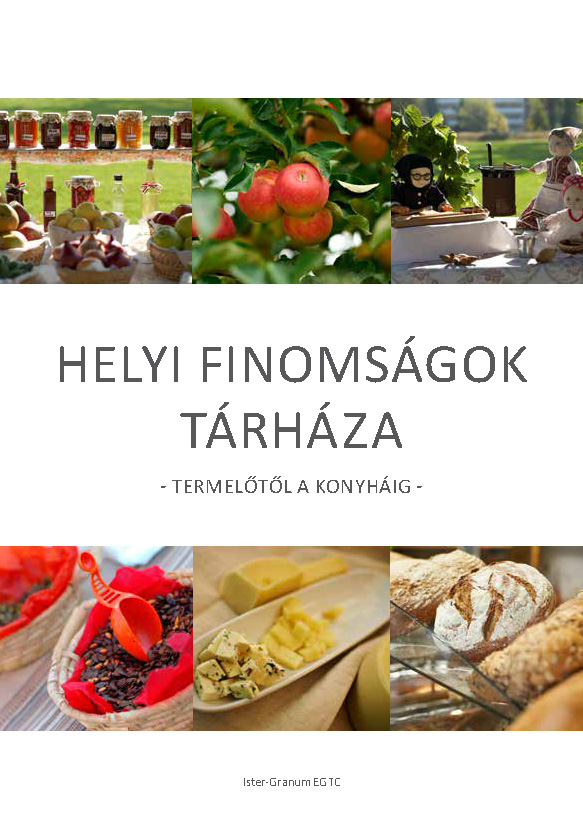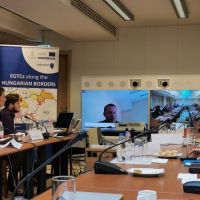
The local product program of the Ister-Granum EGTC
The Ister-Granum local product program initiated by CESCI was launched by involving local and national experts in 2012. Within the framework of the project several synergistic interventions are implemented by an integrated manner. After almost 10 years, the process is starting to generate more and more cross-border results, such as joint projects, publications and the Territorial Action Plan for Employment granted by the Interreg V-A Slovakia-Hungary Cooperation Programme.
Objectives of the program
- to ensure the access to market for local farmers, hereby promoting the alternative income generating ways; and to reduce unemployment;
- to establish and strengthen the local product market’s network in the area of the EGTC, to promote these markets, to improve their acknowledgement, to facilitate the set-up of new ones;
- to support farmers’ networking; to bolster their cross-border cooperation;
- to increase the demand of local products within the region and their role in mass catering;
- to promote the Ister-Granum EGTC, to strengthen its internal social cohesion.
(Planned) Activities of the project
1. Networking
Within the framework of the project networking of local farmers and markets is implemented. The measure includes the following activities:
1.1 Database development
The aim of the measure is to set up and continuously refresh the database of local farmers, producers and markets. The database also provides opportunity to establish an on-line sales platform. The further developments will aim at the set-up of a database with appropriate data security measures.
1.2 Development of cooperation between markets
Recently the markets are able to serve the demand of their close neighbouring areas; cooperation is not required to maintain this present state. However the project aims at setting up more and more markets without reducing each other’s attractiveness. Hereby the conditions of the cooperation of the existing and planned markets must be worked out. Its elements: the market’s mutual advertisement, marking out special market days for each market, joint presence of the farmers on national and international fairs with a unique image. For the sake of this it is required to establish a common platform of the market organisers where agreement on the above questions may be concluded and where the coordination of further work is possible.
1.3 Organisation of study tours
Within the framework of the project two study tours are planned to be organised for the local farmers and the market organisers. Two groups of 10 people visit such target areas where the local supplier network and local product sales are meet high standards.
2. Ensuring the conditions for joint presence
In order to ensure the visibility and intelligibility of the cooperation between the local (already existing or planned) markets the creation of a joint brand is required. The background for the brand may be offered by the Ister-Granum EGTC.
2.1 Branding
Within the framework of the project we establish the EGTC brand of local products. The classification and the sales of the appropriate quality products are ensured by the brand which, at the same time, makes cross-border cooperation visible.
To the introduction of the brand we make a protocol and work out the draft version of the joint design as well. We ensure the sale of selected local products by using the same design elements.
2.2 On-line sales and marketing portal
The on-line sales portal aims at facilitating the products’ access to the market and providing a meeting point for the shopping communities, mass caterers, farmers and producers. In addition the news of the markets, training materials and joint actions are also published here.
2.3 EGTC installations
The planned installations contribute to the joint presence of the network on EGTC level. On the one hand uniformed set of shelves (20 pieces) will be made and placed at the frequented tourist sites of the region (these shelves will be refilled with fresh products by the employees of the organisations responsible for the sustainability of the project), and 15 stands with the same design will also be prepared deserving the joint presence on bigger fairs.
3. Promotion, awareness-raising
Beside network development activities, for the sake of expanding the local product markets strengthening the demand is also necessary. It is important to reach that lots of households and public institutions of the region use local products, and that the bigger companies also become consumers as part of their PR activity. To this end we plan a significant role of awareness-raising activities within the framework of the project. It includes the following measures.
3.1 Printing promotional brochures
We place the multilingual brochure promoting open farms and local product markets at the frequented tourist sites of the region which allows tourists to visit a given farm or market. A bilingual brochure aiming to increase the number of local producers in the region will also be published accompanied with a promoting leaflet which will be spread at the whole region.
3.2 Promotional events
With the aim of sensitisation, two or three bigger events are planned to be organised which provide opportunity for local producers to introduce themselves. Art performances matching the theme of the certain fairs will also be included into the program of the events.
3.3 Mentoring
The management responsible for the operation of the network launches a mentoring program which has two missions: it organises trainings for those aiming to become a local producer, for producers, farmers and mass caterers; and offers professional assistance for markets and open farms.
4. Distribution management
Sales of the local products is necessary for the maintenance of the project and the operation of the planned cluster. Hereby one of the most important tasks of the project is to discover and operate the sales opportunities.
4.1 Local distribution
It is practical to find demand locally for the products made in the region. Local markets means only one form of it, in addition we will promote and incite the set-up of shopping communities. We would like to provide local ingredients for the mass caterers as well. For the sake of this we organise awareness-raising programs for the employees of local municipalities and ensure the distribution channel through the cluster.
4.2 On-line distribution (see measure 2.2)
One of the results of the project is the local product website of the EGTC which provides a meeting point for the producers and the consumers. The portal is not designed to be a webshop but to ensure a wide range of information for both the demand and supply sides. In addition it also promotes the markets and the local product cluster too.
4.3 Placement of local product shelves (see measure 2.3)
We plan to place local product shelves with a uniform brand at 20 frequented points at the region which are refilled and refreshed by the cluster. Hereby we aim at supporting mainly the sales of products with touristic purposes. The shelves are designed uniformly for the sake of eased identification.
5. Institutional background
The operation of the network and the sustainability of the project fundamentally depend on how the establishment of the financial and institutional background is ensured. The final institutional form will be defined in course of the professional workshops (3 events) organised within the framework of the project. Basically, we plan to set up a cluster, a solution designed for loose form of cooperation. The cluster responsible for sustaining the project results will be founded by local farmers, market organisers, the lead partner Esztergom Environment Culture Association (Esztergomi Környezetkultúra Egyesület), further NGOs and the Ister-Granum EGTC. A non-profit ltd. established by the lead partner and the EGTC hereby providing the municipal and civil background at the same time is seen as the best solution guaranteeing the sound operation of the system.

